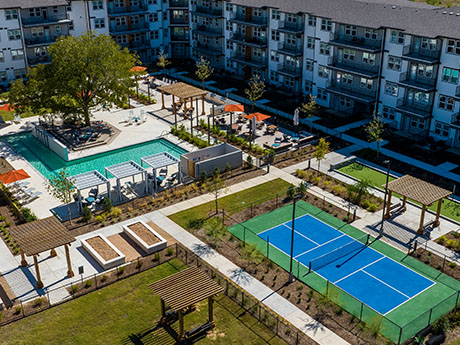By Shawn Reed of FK Architecture
A focus on wellness and lifestyle is among the top 10 senior housing trends for 2025, according to the Seniors Blue Book. With an increased focus on wellness spaces, community gardens and outdoor areas that can be utilized for different activities, seniors now have more opportunities to live healthier, more satisfying lives.

Landscape architects are uniquely suited to provide ways for seniors to experience the outdoors in a safe, accessible way. Ideally, this involves targeted, evidence-based design that emphasizes connection to nature while meeting seniors’ preferences for where they prefer to be and interact with others. Focusing on the important aspects of amenity design can improve health, foster a broader sense of community and increase positive interactions among seniors of all ages.
Strategic Amenity Location
The “attention restoration theory” research conducted by Stephen and Rachel Kaplan shows the benefits humans get from being more in touch with nature. In seniors, increased time outdoors can result in health benefits such as better sleep, decreased incontinence, pain reduction and longevity. Granting residents proper amenity access to the outdoors also promotes mental acuity and psychological wellbeing.
Landscape architects have the opportunity to create amenities such as onsite community gardens or outdoor wellness spaces to help residents lead healthier, more fulfilling lives and receive the benefits of nearby nature.
An American Society of Landscape Architects study found that landscape features substantially influence the time residents spend outdoors. Situating amenities where people prefer to be congregate and convenient to where individuals already spend time — like outdoor spaces near the dining room where seniors can easily join a yoga or tai chi class or sunset social hour — increases engagement in events and social interaction among residents. The communal nature of such spaces also leads to higher participation rates among seniors.
Making garden spaces visible from the indoors encourages seniors to enjoy them. Furthermore, gardens offer an opportunity for resident involvement, as residents can plant and harvest their own crops, which then appear in the residents’ meals, creating a sense of both personal pride and communal joy.
Outdoor activity areas must also be designed to be accessible via safe, well-lit and well-maintained pathways. For instance, making careful design decisions — such as automatic light sensors and sidewalks that are curbed near any slope — is key and upholds crime prevention through environmental design (CPTED). When residents feel safe, they will use outdoor areas more often.
Offering a ‘Nudge‘
With senior living amenities, the “nudge theory” pioneered by Richard Thaler and Cass Sunstein can be applied by designers to subtly influence behavior. This involves making careful choices regarding architectural layouts. It can be as simple as providing large windows such that residents indoors can see their fellow community members enjoying the outside — this constitutes the “nudge” to join in.
Current trends for senior housing facilities also include public-facing businesses such as cafes and coffee shops. Not only do these amenities promote intergenerational connection, they help reduce isolation and ageism, allowing seniors to meet up with family members and friends of different ages and interact with the public.
Designing for Habit Formation and Stacking
Good design also encourages residents to form fitness, social and health habits. Include fitness elements alongside pathways the potential user would want to be on anyway, such as outdoor senior fitness equipment proximate to a walkway that has birdfeeders, birdhouses or chicken roost viewing. Incorporate diverse seating and viewing elements outside to provide options for meeting others and seeing nature in different ways throughout the seasons.
With greater participation, “habit stacking” — the act of attaching a new habit to one that is already being done consistently, such as going out for a group walk after a healthy dinner every day — becomes natural for residents and increases physical fitness and emotional health in a positively reinforced cycle.
Reducing Cognitive Load While Providing Options
While it is important that seniors feel independent and empowered to make significant decisions for themselves, innovative design can also make smaller choices easier, reducing cognitive load. This can be as practical as clear wayfinding and signage so seniors can easily process and navigate pathways, rather than spending precious mental energy on finding their way around a garden path.
The use of color as an environmental cue can be used to signal activity and rest spaces to residents, and making programming and scheduling choices available on an event lawn can ensure that they are predictable and easy to find and attend.
Encouraging Use and Interaction as Seniors Age
Senior living design outcomes must make residents feel comfortable and safe, allowing residents to thrive. It is up to designers to ensure residents are not “hidden away,” and that they are thoughtfully integrated into the community, can enjoy the outdoors and interact with others.
A 95-year-old relative of mine was discontent with her assisted living facility. The spaces caused her to reflect on fellow residents who passed away rather than encouraging her to engage with other residents and amenities. Design elements that encourage amenity use and interaction as seniors age is paramount, so that a senior living facility is not stratified along age lines and instead creates a community that is more adaptive and has more positive places for interaction.
Interactive, engaging and communal amenities enhance individual wellbeing while encouraging socialization across the generations. This new paradigm for senior living focuses on such amenities and ensures that seniors housing facilities are, in fact, true communities with fulfilling opportunities to explore and discover.
— Shawn Reed is a senior planner and landscape architect with FK Architecture


